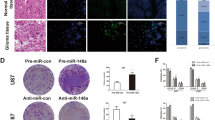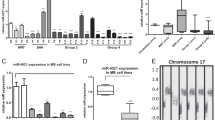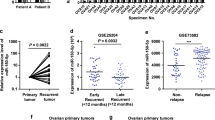Abstract
Meningiomas are frequent, mostly benign intracranial or spinal tumors. A small subset of meningiomas is characterized by histological features of atypia or anaplasia that are associated with more aggressive biological behavior resulting in increased morbidity and mortality. Infiltration into the adjacent brain tissue is a major factor linked to higher recurrence rates. The molecular mechanisms of progression, including brain invasion are still poorly understood. We have studied the role of micro-RNA 145 (miR-145) in meningiomas and detected significantly reduced miR-145 expression in atypical and anaplastic tumors as compared with benign meningiomas. Overexpression of miR-145 in IOMM-Lee meningioma cells resulted in reduced proliferation, increased sensitivity to apoptosis, reduced anchorage-independent growth and reduction of orthotopic tumor growth in nude mice as compared with control cells. Moreover, meningioma cells with high miR-145 levels had impaired migratory and invasive potential in vitro and in vivo. PCR-array studies of miR145-overexpressing cells suggested that collagen type V alpha (COL5A1) expression is downregulated by miR-145 overexpression. Accordingly, COL5A1 expression was significantly upregulated in atypical and anaplastic meningiomas. Collectively, our data indicate an important anti-migratory and anti-proliferative function of miR-145 in meningiomas.
This is a preview of subscription content, access via your institution
Access options
Subscribe to this journal
Receive 50 print issues and online access
$259.00 per year
only $5.18 per issue
Buy this article
- Purchase on Springer Link
- Instant access to full article PDF
Prices may be subject to local taxes which are calculated during checkout





Similar content being viewed by others
References
CBTRUS. Central brain tumor registry of the United States 2012.
Mawrin C, Perry A . Pathological classification and molecular genetics of meningiomas. J Neurooncol 2010; 99: 379–391.
Perry A, Scheithauer BW, Stafford SL, Lohse CM, Wollan PC . "Malignancy" in meningiomas: a clinicopathologic study of 116 patients, with grading implications. Cancer 1999; 85: 2046–2056.
Watson MA, Gutmann DH, Peterson K, Chicoine MR, Kleinschmidt-DeMasters BK, Brown HG et al. Molecular characterization of human meningiomas by gene expression profiling using high-density oligonucleotide microarrays. Am J Pathol 2002; 161: 665–672.
Stuart JE, Lusis EA, Scheck AC, Coons SW, Lal A, Perry A et al. Identification of gene markers associated with aggressive meningioma by filtering across multiple sets of gene expression arrays. J Neuropathol Exp Neurol 2011; 70: 1–12.
Haase D, Schmidl S, Ewald C, Kalff R, Huebner C, Firsching R et al. Fatty acid synthase as a novel target for meningioma therapy. Neuro Oncol 2010; 12: 844–854.
Mawrin C, Wolke C, Haase D, Krüger S, Firsching R, Keilhoff G et al. Reduced Activity of CD13/aminopeptidase N (APN) in aggressive meningiomas is associated with increased levels of SPARC. Brain Pathol 2009; 20: 200–210.
Calin GA, Croce CM . MicroRNA signatures in human cancers. Nat Rev Cancer 2006; 6: 857–866.
Takamizawa J, Konishi H, Yanagisawa K, Tomida S, Osada H, Endoh H et al. Reduced expression of the let-7 microRNAs in human lung cancers in association with shortened postoperative survival. Cancer Res 2004; 64: 3753–3756.
Liang S, He L, Zhao X, Miao Y, Gu Y, Guo C et al. MicroRNA let-7f inhibits tumor invasion and metastasis by targeting MYH9 in human gastric cancer. PLoS One 2011; 6: e18409.
Shi B, Sepp-Lorenzino L, Prisco M, Linsley P, deAngelis T, Baserga R et al. Micro RNA 145 targets the insulin receptor substrate-1 and inhibits the growth of colon cancer cells. J Biol Chem 2007; 282: 32582–32590.
La Rocca G, Shi B, Badin M, De Angelis T, Sepp-Lorenzino L, Baserga R et al. Growth inhibition by microRNAs that target the insulin receptor substrate-1. Cell Cycle 2009; 8: 2255–2259.
Gao P, Xing A-Y, Zhou G-Y, Zhang T-G, Zhang J-P, Gao C et al. The molecular mechanism of microRNA-145 to suppress invasion–metastasis cascade in gastric cancer. Oncogene 2012; 32: 491–501.
Gotte M, Mohr C, Koo CY, Stock C, Vaske AK, Viola M et al. miR-145-dependent targeting of junctional adhesion molecule A and modulation of fascin expression are associated with reduced breast cancer cell motility and invasiveness. Oncogene 2010; 29: 6569–6580.
Saydam O, Shen Y, Wurdinger T, Senol O, Boke E, James MF et al. Downregulated microRNA-200a in meningiomas promotes tumor growth by reducing E-cadherin and activating the Wnt/beta-catenin signaling pathway. Mol Cell Biol 2009; 29: 5923–5940.
Zaman MS, Chen Y, Deng G, Shahryari V, Suh SO, Saini S et al. The functional significance of microRNA-145 in prostate cancer. Br J Cancer 2010; 103: 256–264.
Suh SO, Chen Y, Zaman MS, Hirata H, Yamamura S, Shahryari V et al. MicroRNA-145 is regulated by DNA methylation and p53 gene mutation in prostate cancer. Carcinogenesis 2011; 32: 772–778.
Koo S, Martin GS, Schulz KJ, Ronck M, Toussaint LG . Serial selection for invasiveness increases expression of miR-143/miR-145 in glioblastoma cell lines. BMC Cancer 2012; 12: 143.
Black PM . Meningiomas. Neurosurgery 1993; 32: 643–657.
Kilic T, Bayri Y, Ozduman K, Acar M, Diren S, Kurtkaya O et al. Tenascin in meningioma: expression is correlated with anaplasia, vascular endothelial growth factor expression, and peritumoral edema but not with tumor border shape. Neurosurgery 2002; 51: 183–192.
Nordqvist AC, Smurawa H, Mathiesen T . Expression of matrix metalloproteinases 2 and 9 in meningiomas associated with different degrees of brain invasiveness and edema. J Neurosurg 2001; 95: 839–844.
De Paepe A, Nuytinck L, Hausser I, Anton-Lamprecht I, Naeyaert JM . Mutations in the COL5A1 gene are causal in the Ehlers-Danlos syndromes I and II. Am J Hum Genet 1997; 60: 547–554.
Symoens S, Malfait F, Renard M, André J, Hausser I, Loeys B et al. COL5A1 signal peptide mutations interfere with protein secretion and cause classic Ehlers-Danlos syndrome. Hum Mutat 2009; 30: E395–E403.
Wenstrup RJ, Florer JB, Davidson JM, Phillips CL, Pfeiffer BJ, Menezes DW et al. Murine model of the Ehlers-Danlos syndrome. col5a1 haploinsufficiency disrupts collagen fibril assembly at multiple stages. J Biol Chem 2006; 281: 12888–12895.
Nitta H, Yamashima T, Yamashita J, Kubota T . An ultrastructural and immunohistochemical study of extracellular matrix in meningiomas. Histol Histopathol 1990; 5: 267–274.
Schittenhelm J, Mittelbronn M, Roser F, Tatagiba M, Mawrin C, Bornemann A et al. Patterns of SPARC expression and basement membrane intactness at the tumour-brain border of invasive meningiomas. Neuropathol Appl Neurobiol 2006; 32: 525–531.
Puttmann S, Senner V, Braune S, Hillmann B, Exeler R, Rickert CH et al. Establishment of a benign meningioma cell line by hTERT-mediated immortalization. Lab Invest 2005; 85: 1163–1171.
Lee WH . Characterization of a newly established malignant meningioma cell line of the human brain: IOMM-Lee. Neurosurgery 1990; 27: 389–395 discussion 396.
Ragel BT, Couldwell WT, Gillespie DL, Wendland MM, Whang K, Jensen RL et al. A comparison of the cell lines used in meningioma research. Surg Neurol 2008; 70: 295–307.
Tanaka K, Sato C, Maeda Y, Koike M, Matsutani M, Yamada K et al. Establishment of a human malignant meningioma cell line with amplified c-myc oncogene. Cancer 1989; 64: 2243–2249.
Kirches E, Andrae N, Hoefer A, Kehler B, Zarse K, Leverkus M et al. Dual role of the mitochondrial protein frataxin in astrocytic tumors. Lab Invest 1766; 91: 1766–1776.
Acknowledgements
The skillful technical work of Ines Schellhase, Ines Meyer and Sandra Hartmann is highly appreciated. We thank Professor Till Acker (University of Giessen) for help with the morphometric quantification of tumor infiltration in mice and Grit Werner for her help with MR imaging. The work was supported by the Wilhelm Sander-Stiftung (grant #2010.017.1).
Author information
Authors and Affiliations
Corresponding author
Ethics declarations
Competing interests
The authors declare no conflict of interest.
Additional information
Supplementary Information accompanies the paper on the Oncogene website
Rights and permissions
About this article
Cite this article
Kliese, N., Gobrecht, P., Pachow, D. et al. miRNA-145 is downregulated in atypical and anaplastic meningiomas and negatively regulates motility and proliferation of meningioma cells. Oncogene 32, 4712–4720 (2013). https://doi.org/10.1038/onc.2012.468
Received:
Revised:
Accepted:
Published:
Issue Date:
DOI: https://doi.org/10.1038/onc.2012.468
Keywords
This article is cited by
-
Drug target therapy and emerging clinical relevance of exosomes in meningeal tumors
Molecular and Cellular Biochemistry (2024)
-
Meningioma animal models: a systematic review and meta-analysis
Journal of Translational Medicine (2023)
-
The integrated multiomic diagnosis of sporadic meningiomas: a review of its clinical implications
Journal of Neuro-Oncology (2022)
-
Integrating random walk and binary regression to identify novel miRNA-disease association
BMC Bioinformatics (2019)
-
Simultaneous analysis of miRNA-mRNA in human meningiomas by integrating transcriptome: A relationship between PTX3 and miR-29c
BMC Cancer (2017)



